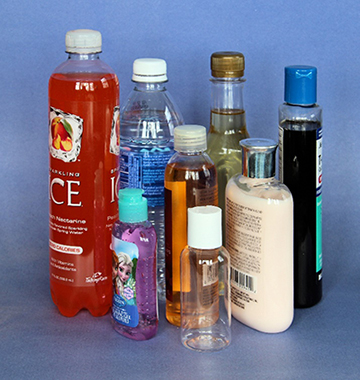

| MAKING A MYSTERY BEAD BOTTLE | |
| When you drop a solid object such as a bead or a stone into a liquid, the object either floats on top of the liquid or sinks to the bottom. In this bead bottle, the beads neither float nor sink completely. The beads are suspended in the middle of the liquid. | |
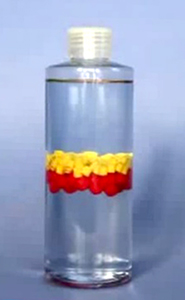 |
|
The beads appear suspended in the middle of the liquid because the bottle contains not one, but two liquids. One of the liquids floats on top of the other liquid. The beads sink in the top liquid, but float on the bottom one. This gives the appearance that the beads are suspended in the middle of the liquid, but in fact the beads rest where the two liquids meet. Furthermore, when this bottle is shaken and set to rest, some of the beads float to the top, while others sink to the bottom. As the bottle rests, the beads that sank to the bottom begin to rise, while those that rose to the top begin to sink. After a short while, the beads return to rest at the middle. |
|
Watch a video of a shaken bead bottle. |
|
| MATERIALS | |
In order to make a mystery bead bottle you will need the following supplies:
Each of these will be described in fuller detail below. In addition to these materials you will need a measuring cup, a spoon for stirring, and a scale that can weigh grams, or a set of measuring spoons if you don’t have such a scale. A funnel to pour liquid into the bottle is handy but not necessary. You will need a bottle, preferably one that is transparent and uncolored, and one that can be securely sealed with a cap. It can be any convenient size, but the larger it is, the more of the other materials you will need. A quart-sized bottle (or 1 liter) is the largest you should consider, because larger bottles will be awkwardly heavy when filled. The smallest would be about 3 ounces (or 100 milliliters), because a smaller bottle will hold too few beads and produce a less appealing effect. A plastic bottle is best, because that will be less likely than glass to break should you drop it. |
|
Bottles suitable for making a Mystery Bead Bottle can be found containing various products. |
|
It is not necessary to find a new bottle to use. You can use one that you already have; one that came with something in it. Beverages, hand cream, shampoo, cooking oil, vinegar, and many other products come in colorless, transparent bottles. If you reuse a bottle, it must be cleaned thoroughly. If it contained an oily substance, be sure to wash it several times with soapy water to remove all the oil. Rinse whatever bottle you use with clear tap water several times. Partially fill the bottle with water, seal it, and shake it vigorously. When you stop shaking it, if the bubbles inside stay for longer than a second, rinse the bottle again, and continue to rinse it until the bubbles disappear immediately when you stop shaking the bottle. |
|
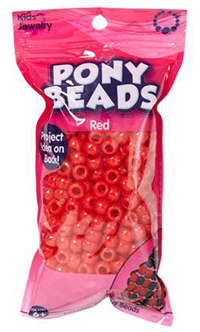 |
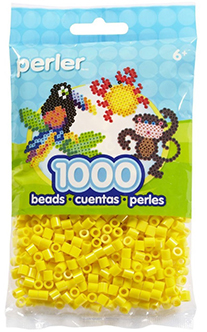 |
Pony beads and Perler beads in two different colors. Two specific kinds of plastic beads will be needed. Both are available at most large craft or hobby stores. The first kind of beads are called pony beads. These come in many different colors. You may use any color you like, though they should all be the same color to produce the clearest effect in the bottle. The second kind of beads are Perler beads. These are used in assembling arrangements that can be fused together into one piece, so they are made of a different material than pony beads. They also come in a variety of colors. You should choose a color distinctly different from the color of the pony beads. The number of beads you need will depend on the size of the bottle you’re using. For a 20-ounce beverage bottle, you’ll need between 100 and 120 beads of each kind. For smaller bottles, you’ll need fewer beads. |
|
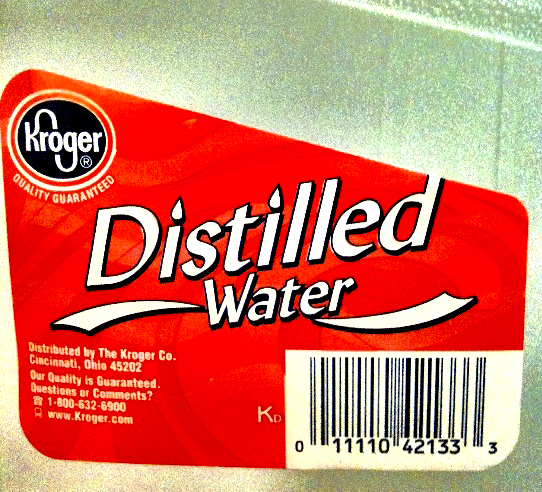 |
|
One of the liquids in the bottle is a salt solution. To make the salt solution, you need to use distilled water. Tap water is not pure enough. The minerals in tap water can make the liquid in the bead bottle cloudy. You will need enough distilled water to fill half of the bottle, plus a little bit more for cleaning the bottle. For example, if you have a 20-ounce beverage bottle, you will need at least 10 ounces of distilled water. |
|
 |
|
The other liquid in the bead bottle is isopropyl alcohol. You can get this at most pharmacies. It is available in several different concentrations (50%, 70%, 91%). To make the bead bottle, you will use 91% isopropyl alcohol. You will need the same volume of the alcohol as of distilled water. |
|
 |
|
The last material you will need to make a mystery bead bottle is salt. This needs to be pure salt, sodium chloride, without any other ingredients. Pickling salt is pure salt. Other types of salt, such as iodized salt, free-flowing table salt, sea salt, and kosher salt all contain other minerals that can make the bottle cloudy. The amount of salt you need will depend on the size of the bottle. For a 20-ounce bottle, you will need about 2.5 ounces (75 grams) of salt. For a smaller bottle, you will need less. |
|
| ASSEMBLING THE BOTTLE | |
To make sure the bottle is free of contaminants, put some distilled water into the bottle, about 1/10 of the bottle’s volume. Cap the bottle and shake it vigorously. Stop shaking and watch the water in the bottle. All bubbles in the bottle should disappear as soon as you stop shaking. If bubbles last as long a few seconds or more, pour out the distilled water and replace it with more distilled water. Repeat the shaking and replacing of water until bubbles disappear immediately. Fill the bottle about half full with distilled water. Pour the water into a measuring cup to determine the volume of the water. For each half-cup (4 fluid ounces or 125 mL) of distilled water, add 1.0 ounce (28 grams) of salt, sodium chloride. If you do not have a scale that measures this accurately, you can approximate this weight of salt by measuring the volume of finely granulated salt instead: for each half-cup of distilled water, use 4 level teaspoons of salt. Adjust the amount of salt proportionately to the volume of water you have. For example, if you have six ounces of water, which is 6/4 times as much water as described above, then you should use 6/4 of the amount of salt, that is 1.5 ounces (42 grams) or 6 level teaspoons of salt. If you have a cup of water, then you will need 2.0 ounces or 8 level teaspoons of salt. Stir the salt-water mixture until all of the salt dissolves. Then pour enough of the solution back into the bottle until the bottle is a little less than half-full. (The volume of the salt solution will be more than the original volume of water, so you won’t need all of the solution.) Pour an equal volume of 91% isopropyl alcohol into the bottle, so the bottle is 80 to 90% full (you need to leave room for the beads, which will be added later). When you add the alcohol, the bottle’s contents may become cloudy; this is OK. Seal the bottle with its cap and gently invert it several times to mix its contents, then set it down to let it rest. The mixture will be cloudy, but gradually it will become clear. After it has become clear, if you look closely near the middle of the bottle, you will be able to see where the two liquids—salt solution and alcohol—meet. Open the bottle and drop into it one of the pony beads. The bead will come to rest where the two liquids meet. Continue adding pony beads until you get a layer about ½ inch (1 cm) thick. Add a Perler bead. It will come to rest on top of the pony beads. Continue adding Perler beads until you have a layer the same thickness as the pony beads. Seal the bottle with its cap. Gently shake the bottle and set it down to rest. The pony beads will sink to the bottom and the Perler beads will float to the top. After a few seconds, the pony beads will begin to rise and the Perler beads will begin to sink. The two sets of beads will continue to rise and sink until they meet again at the middle of the bottle. You can send the beads through a cycle as often as you like. |
|
| HOW THE MYSTERY BEAD BOTTLE WORKS | |
The mystery bead bottle contains two liquids, a concentrated solution of salt (sodium chloride) in water and isopropyl alcohol. The two liquids do not mix. Although isopropyl alcohol will mix completely with pure water, the salt dissolved in the water prevents the alcohol from mixing. The salt solution is denser than the isopropyl alcohol. The density of the salt solution is 1.13 grams per cubic centimeter, 1.13 g/cm3. The density of the alcohol in the bottle is about 0.88 g/cm3. (This is greater than the density of pure isopropyl alcohol, because there is some water dissolved in the alcohol.) Therefore, the salt solution sinks to the bottom, and the isopropyl alcohol floats on top. There are two different kind of beads in the bottle. The larger pony beads have a density of 1.02 g/cm3. The smaller Perler beads have a density of 0.90 g/cm3. Both kinds of bead are less dense than the salt solution, so they float on the salt solution. They are both denser than the isopropyl alcohol, so they sink to the bottom of the alcohol. They rest were the two liquids meet, in the middle of the bottle. When the bottle is shaken, the salt water and isopropyl alcohol are mixed together and form a temporary emulsion (tiny drops of each liquid mixed together). The density of the emulsion is the average of the densities of the two liquids, namely (1.13 + 0.88)/2 or 1.00 g/cm3. The density of the emulsion is less than the density of the pony beads, so the pony beads sink to the bottom in the emulsion. The density of the emulsion is greater than the density of the Perler beads, so the Perler beads float to the top of the emulsion. As the bottle rests, the emulsion separates into its two components. The salt water separates at the bottom and the alcohol at the top. The pony beads float to the top of the salt water, but stay below the emulsion. The Perler beads sink to the bottom of the alcohol, but remain above the emulsion. As the emulsion separates, the beads come together again at the middle of the bottle. |
|
